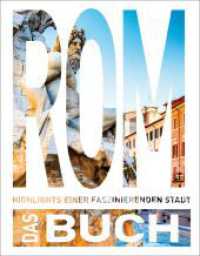- ホーム
- > 洋書
- > 英文書
- > History / World
Full Description
The sensational discovery in 1922 of Tutankhamun's tomb, close on the heels of Britain's declaration of Egyptian independence, accelerated the growth in Egypt of both Egyptology as a formal discipline and of 'pharaonism'-popular interest in ancient Egypt-as an inspiration in the struggle for full independence. Emphasizing the three decades from 1922 until Nasser's revolution in 1952, this compelling follow-up to Whose Pharaohs? looks at the ways in which Egypt developed its own archaeologies-Islamic, Coptic, and Greco-Roman, as well as the more dominant ancient Egyptian. Each of these four archaeologies had given birth to, and grown up around, a major antiquities museum in Egypt. Later, Cairo, Alexandria, and Ain Shams universities joined in shaping these fields. Contesting Antiquity in Egypt brings all four disciples, as well as the closely related history of tourism, together in a single engaging framework. Throughout this semi-colonial era, the British fought a prolonged rearguard action to retain control of the country while the French continued to dominate the Antiquities Service, as they had since 1858.
Traditional accounts highlight the role of European and American archaeologists in discovering and interpreting Egypt's long past. Donald Reid redresses the balance by also paying close attention to the lives and careers of often-neglected Egyptian specialists. He draws attention not only to the contests between westerners and Egyptians over the control of antiquities, but also to passionate debates among Egyptians themselves over pharaonism in relation to Islam and Arabism during a critical period of nascent nationalism.Drawing on rich archival and published sources, extensive interviews, and material objects ranging from statues and murals to photographs and postage stamps, this comprehensive study by one of the leading scholars in the field will make fascinating reading for scholars and students of Middle East history, archaeology, politics, and museum and heritage studies, as well as for the interested lay reader.
Contents
Introduction
Part I
Ch. 1 Egyptology and Pharaonism in Egypt before Tutankhamun
Ch. 2 Nationalizing Tutankhamun
Ch. 3 Western Egyptology in Egypt in the Wake of Tutankhamun
Ch. 4 Egyptian Egyptology and Pharaonism in the Wake of Tutankhamun
Part II
Ch. 5 Consuming Antiquity: Tourism between Two Revolutions, 1919-1952
Ch. 6 In the Shadow of Egyptology: Islamic Art and Archaeology to 1952
Ch. 7 Copts and Archaeology: Sons of St. Mark/ Sons of the Pharaohs
Ch. 8 Alexandria, Egypt, and the Greco-Roman Heritage
Part III
Ch. 9 Contesting Egyptology in the 1930s
Ch. 10 Pharaonism and Its Challengers in the 1930s and 1940s
Ch. 11 Egyptology in the Twilight of Empire and Monarchy, 1939-1952
Ch. 12 Conclusion
Bibliography








